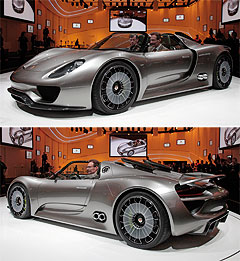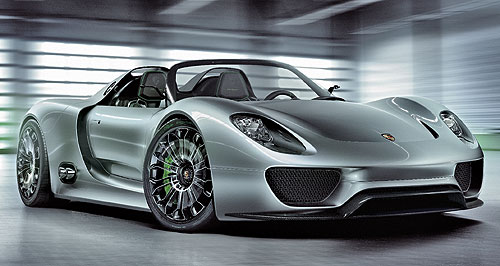Make / Model Search
Future models - Porsche - 918 - SpyderGeneva show: Porsche unveils super plug-inPower plus: The plug-in hybrid Porsche 918 concept can travel 25km on battery power. Porsche unveils a plug-in hybrid supercar with a 375kW-plus V8 returning 3.0L/100km2 Mar 2010 PORSCHE has unveiled a ground-breaking new plug-in hybrid supercar concept that packs a 375kW-plus V8 and sets a new production car acceleration record for the brand with a 0-100km/h time of less than 3.2 seconds - yet is said to return Prius-beating fuel consumption of just 3.0L/100km. The radical show car made its world debut at this week’s Geneva motor show, alongside three further global premieres in the second-generation Cayenne SUV – including the German maker’s first petrol-electric production model, the Cayenne S Hybrid – the 911 range-topping Turbo S and Porsche’s ground-breaking new 911 GT3 hybrid racer. While the GT3 hybrid is the first racecar from the Stuttgart marque to feature an electrically driven front axle, the mid-engined two-seat super-convertible - revealed in Geneva on the eve of the Swiss spectacular by Porsche president and CEO Michael Macht – combines a 500hp-plus V8 with an electric motor for both the front and rear axles. While the mid-mounted V8 is derived from the 3.4-litre racing engine fitted to Porsche’s RS Spyder track car and spins to an astonishing 9200rpm, the combined mechanical output of both electric motors is 160kW, bringing total power output to more than 530kW. Power is transmitted to the wheels by Porsche’s (PDK) seven-speed double-clutch automated manual transmission, which also feeds electric power to the rear axle, while the second motor powers the front wheels through a fixed transmission ratio. As with other plug-in hybrids, a liquid-cooled lithium-ion battery, positioned behind the passenger cell, can be recharged via a regular mains power outlet, while a kinetic energy recovery system also charges it under brakes.  Left: Porsche AG president and CEO Michael Macht and former WRC driver Walter Röhrl present the Porsche 918 Spyder concept. Left: Porsche AG president and CEO Michael Macht and former WRC driver Walter Röhrl present the Porsche 918 Spyder concept.Four running modes are available via a steering wheel button, including an all-electric E-Drive mode that is available for up to 25km and a Sport Hybrid mode that employs both drive systems with the focus on performance, in which power is directed mostly to the rear wheels, which are aided by the 911’s new Torque Vectoring system. Then there is Race Hybrid mode, in which both drive systems operate at their full potential to deliver maximum performance. Finally, the E-Boost mode can be accessed, if the battery is sufficiently charged, via a ‘push-to-pass’ button that delivers additional electrical power. It is this feature that Porsche says transforms the 918 Spyder concept from a mild-mannered eco-car that can emit at little at 70 grams of CO2 per kilometre, to a racetrack-scorching supercar capable of more than 320km/h. Built on a modular monocoque bodyshell made from carbon-fibre-reinforced plastic (CFRP) and also featuring extensive use of magnesium and aluminium to lower weight while increasing torsional stiffness, Porsche says the sub-1490kg Spyder can lap the Nurburgring in as little as 7:30 minutes – less than Porsche’s million-dollar Carrera GT flagship. Apart from advancing a number of steps further than the petrol-electric system seen in Porsche’s LeMans hope, the 911 GT3 R Hybrid, the 918 Spyder is reported to preview an eventual replacement for Porsche’s discontinued flag bearer, the Carrera GT supercar. Significantly, Mr Macht made a point of reiterating the fact that Porsche has never shown a concept car that didn't into production, but added that the company would gauge public reaction to the show car before committing to a showroom version. Combining cutting-edge technology with classic Porsche styling cues that make it reminiscent of the 917 and RS Spyder racers, the 918 features variable aerodynamic aids including rear “hoods” that extend out from the head restraints and also accommodate retractable air intakes with a ram-air function. The 918 Spyder interior features three free-standing circular dials for road speed on the left, engine rpm in the centre and energy management at the right, designed to look like the cockpit of a 1960s racecar. In contrast, the Spyder’s forward-rising centre console houses a high-tech touch-sensitive surface to intuitively control the car’s primary functions.  Read more26th of February 2010  Geneva show: Porsche uncovers leaner new CayennePorsche confirms lighter, more efficient MkII Cayenne will be here in four months18th of February 2010  First look: Porsche produces Panamera V6First Porsche-designed V6 to power most basic Panamera - due here in June1st of February 2010  Porsche claws back salesGlobal sales and revenue figures increase as Porsche forecasts a healthy first half1st of February 2010  Next Cayenne surfaces as Roxster, sub-Boxster firmed upPorsche puts sub-Cayenne and Boxster models on drawing board as new Cayenne surfaces13th of November 2009  Porsche holds tight on product reinsShared models not a problem, as long as we lead development, says PorscheAll motor show Alfa Romeo Alfa Romeo Abarth Abarth Alpine Alpine Alpina Alpina Audi Audi Aston Martin Aston Martin BMW BMW Bentley Bentley Chery Chery Brabham Brabham Chrysler Chrysler Chevrolet Chevrolet Cupra Cupra Citroen Citroen DS DS Dodge Dodge Fiat Fiat Ferrari Ferrari Foton Foton Ford Ford Great Wall Great Wall FPV FPV Haval Haval GWM GWM Honda Honda Holden Holden Hummer Hummer HSV HSV Infiniti Infiniti Hyundai Hyundai Jaguar Jaguar Isuzu Isuzu Kia Kia Jeep Jeep Land Rover Land Rover Lamborghini Lamborghini Lexus Lexus LDV LDV Mahindra Mahindra Lotus Lotus Mazda Mazda Maserati Maserati Mercedes-AMG Mercedes-AMG McLaren McLaren MG MG Mercedes-Benz Mercedes-Benz Mitsubishi Mitsubishi Mini Mini Opel Opel Nissan Nissan Peugeot Peugeot Pagani Pagani Proton Proton Porsche Porsche Renault Renault Ram Ram Rover Rover Rolls-Royce Rolls-Royce Skoda Skoda Saab Saab SsangYong SsangYong Smart Smart Suzuki Suzuki Subaru Subaru Toyota Toyota Tesla Tesla Volvo VolvoMotor industry news |
Click to shareAll motor show Alfa Romeo Alfa Romeo Abarth Abarth Alpine Alpine Alpina Alpina Audi Audi Aston Martin Aston Martin BMW BMW Bentley Bentley Chery Chery Brabham Brabham Chrysler Chrysler Chevrolet Chevrolet Cupra Cupra Citroen Citroen DS DS Dodge Dodge Fiat Fiat Ferrari Ferrari Foton Foton Ford Ford Great Wall Great Wall FPV FPV Haval Haval GWM GWM Honda Honda Holden Holden Hummer Hummer HSV HSV Infiniti Infiniti Hyundai Hyundai Jaguar Jaguar Isuzu Isuzu Kia Kia Jeep Jeep Land Rover Land Rover Lamborghini Lamborghini Lexus Lexus LDV LDV Mahindra Mahindra Lotus Lotus Mazda Mazda Maserati Maserati Mercedes-AMG Mercedes-AMG McLaren McLaren MG MG Mercedes-Benz Mercedes-Benz Mitsubishi Mitsubishi Mini Mini Opel Opel Nissan Nissan Peugeot Peugeot Pagani Pagani Proton Proton Porsche Porsche Renault Renault Ram Ram Rover Rover Rolls-Royce Rolls-Royce Skoda Skoda Saab Saab SsangYong SsangYong Smart Smart Suzuki Suzuki Subaru Subaru Toyota Toyota Tesla Tesla Volvo VolvoMotor industry news |











Facebook Twitter Instagram